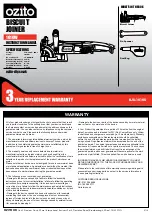
BJk-1010u
6. MAKING A CUT
7. JOINING
CAuTION:
TO REduCE ThE RISk Of ELECTRICAL ShOCk,
WE RECOMMENd ThE uSE Of A RESIduAL CuRRENT
dEvICE (RATEd 30MA OR LESS).
1 Plug the power cord into the
power supply.
2 Hold the biscuit joiner
firmly using both
handles.
1 Once all biscuit slots
have been cut, place a
biscuit in each joint.
4 Push the lock off switch
forward and depress the
on/off trigger to start the
tool.
Note:
Allow the biscuit
joiner to reach
maximum speed.
3 Finally, disassemble the
workpieces and place a
bead of glue in each slot
as well as over the entire
joining face.
Note:
If necessary, remove
any pencil markings
before applying glue.
5 Clamp the workpieces
together until the glue
sets.
Note:
Refer to the glue
manufacturer’s
recommended
setting times before
removing the clamps.
6 Once the cut is complete
allow the biscuit joiner
blade to retract and then
release the on/off trigger.
3 Place the fence flush against
the workpiece and align the
centreline indicator with the
centreline marking on the
workpiece.
2 Assemble the piece without
glue first to ensure the
workpieces line up and
biscuits fit as required.
4 Reinsert the biscuits and
assemble the work pieces.
Note:
Refer to the biscuit guide
for more information
relating to glue and biscuit
joints.
5 Push the biscuit joiner forward
to extend the blade into the
workpiece.
a
b










